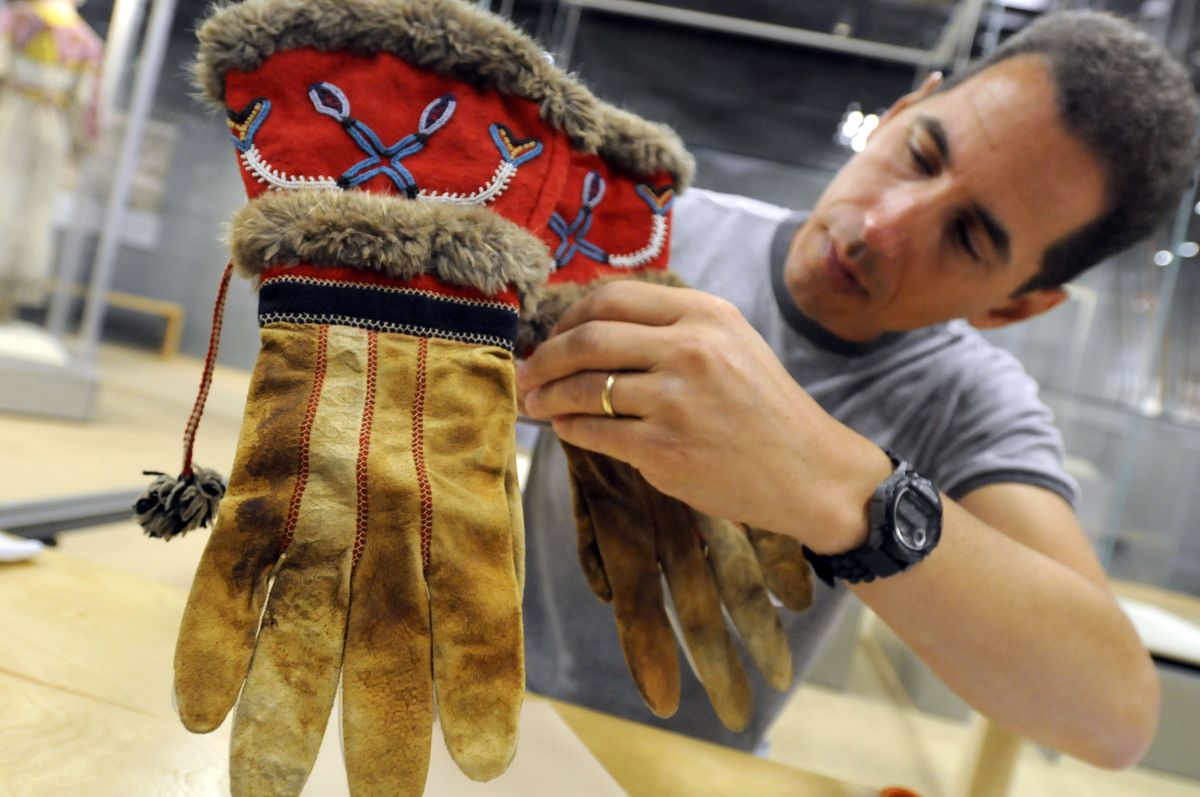MAC originals
Much of ‘Living Legacy’ – an American Indian exhibit from the early 1900s – began at the Spokane museum

“Living Legacy: The American Indian Collection” contains, among its 192 objects, a large, flat-twined bag from the Spokane tribe. Museum accession number: 1.1.
Which means it carries a special status at the Northwest Museum of Arts and Culture: This is the first object, from the first collection, ever acquired by the museum.
“Living Legacy,” which opened Saturday and will run for two years, is centered around the W.M. Manning collection of Native American objects, which was loaned to the fledgling museum in 1916 and later donated. It was the founding collection of what has evolved into the MAC.
So “Living Legacy” has a “certain romance from a museological standpoint,” according to Laura Thayer, one of the curators.
Yet its importance goes far beyond that. This is the first time the MAC has shown off its world-class Native American collection since opening its new building in 2001. The museum has 17,000 American Indian objects, many of which have been boxed up since the move. Now, finally, the cream of the collection will be on display.
Along with dozens of items from the Manning collection, it also contains a number of more recently acquired items.
Visitors will see:
• A wood-and-bark Kalispel canoe, made by Chief Massalaw of the Kalispel tribe in 1905 specifically for Manning.
• Traditional handmade bows and arrows.
• Several complete clothing outfits from around a century ago.
• A “Man’s Chicken Dance Bustle and Dance Stick,” made last year by artist George Flett.
• A flat-twined bag made by a tribal weaver from a design Manning provided to her – a Masonic emblem.
Who was this guy Manning, and how did he acquire all of these tribal items?
The answer helps explain why the collection is both so valuable and so controversial. Even the museum didn’t know the truth until recently.
“Originally, we thought this exhibit would be about Victorian collectors and their legacy, good and bad,” said Thayer. “We hired Jack Nisbet (a local historian and author) to do some research. Jack discovered that William Manning was not a typical Victorian collector, the way we imagined. He appears to be friends with many of these people. Or maybe it was a financial arrangement.”
Manning was a surveyor for Stevens County in the early 1900s whose job included surveying reservation lands. Through the course of his work, he acquired many objects from the tribal people, either through friendship, through commissions, or through – well, other means.
“He was collecting objects out of friendship, but also collecting objects from a grave that he may have walked over,” said Michael Holloman, the director of the MAC’s Center for Plateau Cultural Studies. “ … Some of the things that Manning collected were among the most disrespectful, challenging things that this museum or any institution has to admit about their past.”
Skeletal remains and other objects from graves were “repatriated” back to the tribes in the 1980s – none are in the MAC’s collection any longer and none are in this exhibit. Yet the fact that Manning’s collection originally included such items raises questions which are tackled directly in the “Living Legacy” exhibit.
Holloman, an enrolled member of the Colville Confederated Tribes, said that the exhibit is also, in a way, the story of how museums have changed their ways from the old Victorian collector days when the museums raised few questions about how an artifact was acquired and to whom it actually belonged. So, on one hand, the exhibit will tell visitors that grave-robbing and other desecrations did happen. In fact, an empty display case stands as a symbol of the missing items. Yet it will also “tell the story of what kind of institution we are now,” said Holloman.
The entire exhibit was planned from the beginning with input from the museum’s American Indian Cultural Council, with representatives from the region’s tribes. And they were not just an advisory committee – they helped shape the focus of the exhibit.
“This is unique for an institution,” said Holloman. “There are very few museums that have a body of tribal representatives that have this amount of authority.”
The words “Living Legacy” were carefully chosen. The “legacy” part of the title refers to both the Native American cultural legacy and the legacy that Manning left to the museum.
Yet the “living” part of the phrase is crucial. One of the goals of the exhibit is to “let people know that we are still here,” in Holloman’s words.
Manning, like other collectors in the late 1800s and early 1900s, was probably operating from the widely shared belief that the tribes would soon be extinct. He was trying to save what he could of a dying culture.
Yet the culture remains very much alive, which is why the “Living Legacy” exhibit contains items from recent years as well.
“The traditions and values that are so important to us as a people are still there,” said Holloman. “They continue.”
Even the older Manning items represent another kind of “living” legacy.
“They are imbued with the prayers that were put into them when they were made,” said Holloman. “When the tribal people were out gathering the bear grass and the ryegrass, or when they shot the deer and took the buckskin, prayers were given. And we still honor that.”
Meanwhile, the “Living Legacy” exhibit will fulfill a more practical need for the MAC. Ever since the museum moved into its new building in 2001, people have been asking, “Where’s the Native American collection?”
The answer, as of this weekend, will be, “Step right in.”